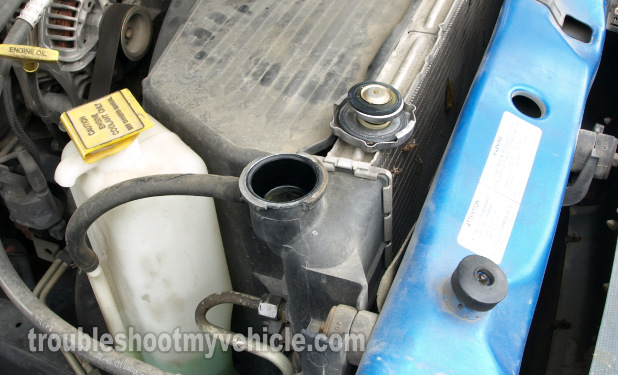TEST 2: Exhaust Gases Shooting Out Of The Radiator

In this test, we're gonna' crank the engine with the radiator's cap removed.
If the coolant, inside the radiator, is shot out while cranking the engine, then you can conclude that one or both of the head gaskets are blown.
CAUTION: Do not remove the radiator cap with a hot engine! If the engine, in your Dodge pickup or van, has been running for any length of time, let it cool down completely before removing the cap from the radiator.
Let's get started:
- 1
Remove the radiator cap from the radiator.
If the radiator is not full, then top it off with water. - 2
Have your helper to crank the engine, while you stand at a safe distance from the open radiator.
- 3
You'll see one of two results:
1.) The water or coolant inside the radiator will shoot up and out of the now open radiator.
2.) The coolant will not be disturbed. In other words, cranking the engine will have no effect on the level of the water or coolant in the radiator.
OK, now that the testing part is done, let's take a look at what your results mean:
CASE 1: The coolant bubbled out or shot out from the radiator. This result confirms a blown head gasket issue and lets you know that the combustion gases are leaking into the cooling system. No further testing is required.
CASE 2: The coolant DID NOT bubble out NOR shoot out from the radiator. This is the correct test result.
If your 3.9L V6 Dodge pickup or van runs but runs with a misfire (or extreme rough idle), go to: TEST 3: Cylinder Compression Test.
If your 3.9L V6 Dodge pickup or van runs but starts to overheat immediately and for no apparent reason, go to: TEST 4: Using A Chemical Block Tester (Combustion Leak Tester).
TEST 3: Cylinder Compression Test

In some cases, the head gasket burns in a spot right between two side-by-side cylinders (you can see an example of this type of problem in the image at the very beginning of this tutorial).
In this cases, the engine usually starts and runs, but it runs with a misfire (or extreme rough idle).
The best way to diagnose this type of head gasket failure is with a compression test.
OK, these are the test steps:
- 1
Disable the ignition system on your 3.9L V6 Dodge van (pickup).
You can easily accomplish this by disconnecting the ignition coil's electrical connector. - 2
Disable the fuel system.
You can do this by disconnecting the fuel injectors' electrical connectors. - 3
Disconnect all spark plug wires (from their spark plugs) and then take out all of the spark plugs.
- 4
Thread in the compression tester by hand, on the first spark plug hole you're gonna' start with.
Do not use any tools to tighten the compression tester. Hand tightening the compression tester is more than enough to get the proper results. - 5
Have a helper crank the engine as you observe the compression tester.
- 6
At the point the gauge's needle stops climbing, have your assistant stop cranking the engine.
- 7
Write down the reading and what cylinder it belongs to (you can use the illustration above to help you identify the cylinder) on a piece of paper.
- 8
Remove the compression tester and repeat the above steps in the remaining cylinders.
OK, let's take a look at what your results mean:
CASE 1: All cylinder compression readings where normal. This is the correct test result and it confirms that both head gaskets are OK (not burned at a spot between two side-by-side cylinders).
If you still suspect a blown head gasket, go to: TEST 4: Using A Chemical Block Tester (Combustion Leak Tester).
CASE 2: Two side by side cylinders had 0 PSI compression. This engine compression reading confirms that the head gasket is burned thru' at the point between those two cylinders. You will need to replace the head gasket.
